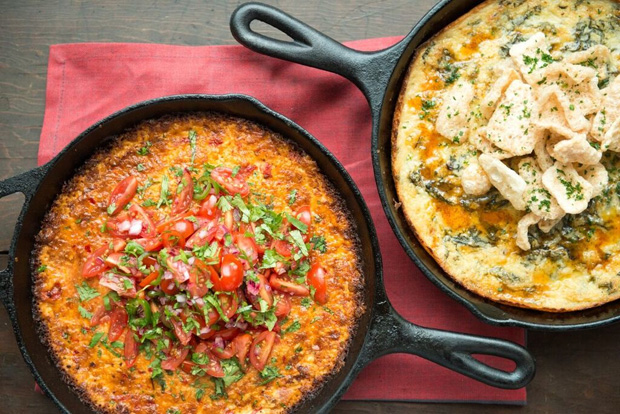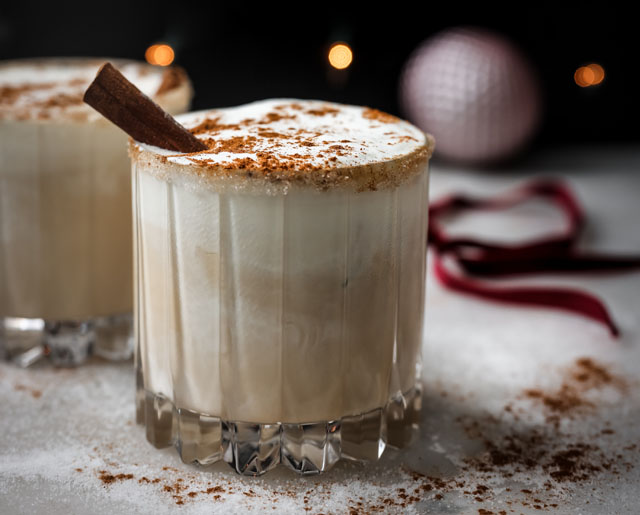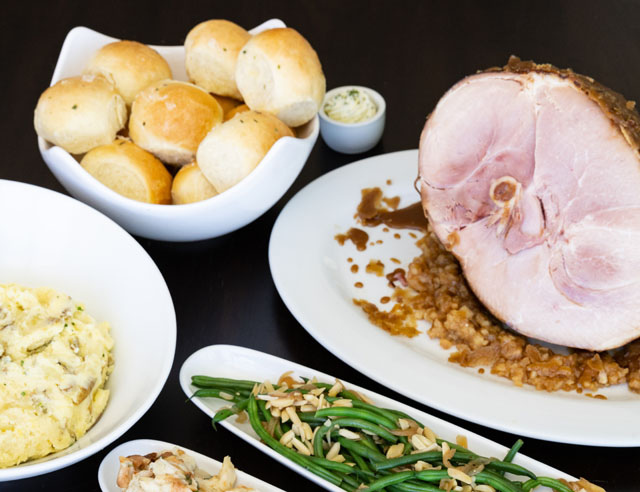Southern Dishes with a Twist
03 Jan 2017
Vivian Howard sat at a folding table, signing copies of her fabulous new cookbook, Deep Run Roots. Named for the tiny community where she spent her childhood, recipes in the book will take you back to your own youth, with a twist and a turn.
Howard spent a very long time writing the book, and it shows. There’s so much more than pretty images and fascinating recipes. It’s the story of her life, “so far,” and in her introduction, she says, “Eastern North Carolina is my Tuscany, my Szechuan, my Provence. This is a southern cookbook, but not one that treats the South like one big region where everybody eats the same fried chicken, ribs, shrimp and grits, collard greens and gumbo.”
Indeed not. Those of us born and raised in the Carolinas know that many of our best recipes reflect the ingredients grown here – often with that twist. The same, but different. Enjoy the journey.
By KATHY PETTIT Recipes By VIVIAN HOWARD Photos by REX MILLER

Baked Pimento Cheese and Sausage
“JUST AFTER I HAPPENED into making blueberry barbecue sauce and found my voice, I started thinking about appetizers that spoke of the region. Pimento cheese and crackers came to mind. And although other chefs have done pimento cheese to accolades, I just didn’t think it fully reflected the dip culture Down East. Then I thought of the artery cement my sister Leraine serves on Christmas Eve. Cream cheese, sausage, and Ro-Tel heated in a crockpot till somebody spoons it into a Frito Scoop.”
Note: Using high-quality cheese makes a big difference here. At the very least, do not use pre-shredded cheese food from a bag. That stuff is often coated with a powdery substance that keeps it from clumping, but it also keeps it from tasting like cheese.
Ingredients
3 cups pimento cheese (recipe follows)
1 pound fresh sausage, cooked and crumbled
â…” cup panko bread crumbs
Pimento Cheese
Makes 3 cups
2 cups grated sharp yellow cheddar (about 10 ounces)
2 cups grated aged white cheddar (about 10 ounces)
½ cup finely diced roasted red peppers or pimentos
â…“ cup crushed canned tomatoes or fresh tomatoes pulsed in a food processor
¼ cup of your favorite mayonnaise
2 tablespoons sour cream
¼ teaspoon hot sauce
½ teaspoon salt (optional)
Preparation
Combine all pimento cheese ingredients (minus the salt) in the bowl of a mixer fitted with the paddle attachment. Process for about 30 seconds on low till you have a slightly creamy cheese spread. Taste, add the salt if you wish, and paddle 10 seconds more. Chill till you’re ready to use.
Preheat your oven to 350°F. Stir together the cold pimento cheese and the cooked, very well drained, and cooled sausage.
Press it down into a 1-quart baking dish or 8-inch cast-iron skillet and top with the panko crumbs. Bake uncovered for 20 minutes. The bread crumbs will not necessarily brown; they are there more to provide texture and to soak up some of the grease that rises to the top. When the baked cheese is done, it will be bubbling around all the edges.
Serve this with saltines, Ritz crackers, or toast. I like some pickles on the side.
Grits and Greens with Hot Sauce and Pork Rinds
Serves 6
“GRITS AND GREENS, a combination introduced by American Indians, are a classic for a reason. Typically made with collards, I chose turnips because I’m a turnip disciple. Use any leafy green that you believe in. This Brown Butter Hot Sauce Vinaigrette couples my obsession with brown butter and all its nutty nose love, with my people’s penchant for dousing stewed greens with chili-laced vinegar. Don’t skip it, please. The acidity, the heat, and the additional fat are all big players here.
These are obvious as a hearty side, but I like to serve them as a shared appetizer. Wherever it shows up in your meal’s progression, don’t miss the chance to treat the pork rinds like chips and the grits like dip!”
Grits and Greens
1 pound turnip greens
4 garlic cloves, minced
2 tablespoons extra virgin olive oil
2 teaspoons salt, divided
¼ teaspoon chili flakes
1 batch Foolproof Grits (recipe follows)
1 cup chicken stock
15 turns of the pepper mill or scant ½ teaspoon black pepper
1 tablespoon butter, divided
1 cup grated Parmigiano-Reggiano
Brown-Butter Hot-Sauce Vinaigrette
4 tablespoons butter
2 tablespoons lemon juice
1 tablespoon hot sauce
¼ teaspoon salt
Cook the greens and assemble the grits: Preheat the oven to 400°F. Cut the tough end off the turnip greens and slice the remaining stem and leaves into ½-inch pieces. In a 10-inch cast-iron skillet, the skillet you will bake the grits in, cook the garlic in the oil over medium heat till it just starts to sizzle.
Quickly, because brown garlic is bitter burned garlic, add the greens, 1 teaspoon salt, and the chili flakes. Using tongs, toss the greens around as they wilt.
Once the greens are just wilted, dump them in a large bowl with the grits, chicken stock, black pepper, 2 teaspoons butter and Parm. Rub the inside of the cast-iron skillet with the remaining 1 teaspoon butter and spoon the grits and greens into it. Slide the skillet onto the middle rack of the oven and bake uncovered for 40 minutes.
Make the vinaigrette and serve: In an 8-inch sauté pan or skillet, melt the butter. Do not use a cast-iron black-bottomed skillet here, because you will not be able to see the butter browning. Once the butter melts, it will foam and fizz and eventually start to brown a little on the bottom. When you see this beginning to happen, make sure you swirl the pan around so that all the milk solids brown evenly. Do not walk away. Once butter is nutty in color as well as aroma, carefully stir in the lemon juice, hot sauce, and salt. Let it bubble up for about 15 seconds, then spoon the hot vinaigrette over the baked grits and top with the pork rinds. Serve right away.
Foolproof Grits
Makes 3 cups
“THERE’S NOTHING SIMPLER than a bowl of grits. Still, very few people I know, except for chefs, cook grits from scratch at home. Instant grits became so popular in the 1980s and ’90s that generations of Southerners have no idea what good grits taste like, or how to prepare them.
I’d like to empower a new generation to make grits at home. I employ a double-boiler situation because I can’t bear standing over something for more than thirty seconds, and the gentler heat safeguards against a burned breakfast. I think it also produces a creamier grit. But you could absolutely do this in a two- or three-quart saucepan over low heat with a watchful eye.
I cook grits in milk, but that’s just personal preference. You could use stock of any kind, water, or heavy cream. What’s important is starting with a quality product. If more than two ingredients are listed on the package, choose different grits.”
Ingredients
1 cup grits
3 ¼ cups milk
1 ½ teaspoons salt
10 turns of the pepper mill or ¼ teaspoon black pepper
1 tablespoon butter
Preparation
In the top section of your double boiler, stir together the grits and the milk. Take a fine-mesh tea strainer and skim away the hulls that float to the top. Getting rid of these will prevent you from having hard, uncooked bits in what should be a creamy finished product. Heat the double boiler over medium high. Whisking every few minutes, run the whisk or spoon around the edges to make sure the grits aren’t sticking. After about 10 minutes, the milk will start to take hold of the starch, and the mixture will thicken slightly. Depending on the grind of your grits, between 25 and 40 minutes in, they will have completely swollen and become one with the milk.
Stir in the salt, pepper, and butter. Serve warm. If they thicken up like cement before you’re able to get them on the table, whisk in warm water or milk to loosen them up. They should be thick, not runny, but should spread when you portion them out.
Hamburger Steak with Red Pea and Onion Gravy
Serves 4
“MY PARENTS ALMOST NEVER COOKED an actual steak, which is most likely a good thing, since it probably would have tasted like warm beef jerky. What we did eat was hamburger steak, and I loved it.
Mom browned the beef in a cast-iron skillet and served it over rice, drowned in a pale thick blanket of gravy made with the pan drippings—a real treat in Mom’s health-conscious household. Flash-forward twenty-five years, and we serve hamburger steak in lieu of real steak at Chef and the Farmer on occasion. Instead of onions, cloves of garlic confit stud the steak. They’re little surprises you mine out as you eat. In place of a gravy made with flour, I cook red peas with caramelized onions and blend that till it looks just like my mom’s gravy. The sum is comforting and nostalgic. Because we’re always trying to balance rich stuff with bright stuff, we pair this with Winter Caviar.”
Hamburger Steak
2 pounds ground beef
1 tablespoon salt
1 teaspoon black pepper
1 teaspoon picked thyme
1/2 cup Garlic Confit cloves (recipe follows)
1 tablespoon vegetable oil
Red Pea and Onion Gravy
Makes 4 cups
2 medium onions, halved and sliced thinly with the grain
1 ½ teaspoons salt, divided
2 tablespoons bacon fat or butter
30 turns of the pepper mill or scant
1 teaspoon black pepper
2 cloves garlic, sliced
â…” cup dried peas, soaked overnight (should yield about 2 cups)
5 cups beef stock or water
2 bay leaves
2 cups milk
Make the gravy: In a 4-quart saucepan, cook the onions and ½ teaspoon of the salt in the bacon fat over medium-low heat till they caramelize, about 30 minutes. They should be a golden brown. Stir in the black pepper and garlic. Cook an additional 2 minutes.
Add the peas, beef stock, and bay leaves. Cover and bring it up to a boil. Cook for about 40 minutes or until the peas are extremely tender.
Transfer the peas, all their liquid, and the remaining 1 teaspoon salt to a blender. Add the milk and blend till it’s super smooth. Depending on how much liquid cooked out of the peas, you may have to add some additional water to achieve the proper consistency. It should look like gravy; adjust accordingly.
For the steak: Preheat your oven to 400°F. Season the beef with the salt, black pepper, and thyme. Sprinkle the garlic cloves over the top and fold them in. Divide the beef into 4 equal portions. We can’t have anybody mistaking these for plain old hamburgers, so shape them into ovals or rectangles.
Heat the vegetable oil in a cast-iron skillet over medium-high heat. Add the steaks and cook on the first side about 4 minutes, or until they’re nicely browned. Flip the steaks and slide the pan into the oven. Cook for 5 more minutes for a medium rare.
Serve the steaks smothered in the gravy.
Garlic Confit
Makes ½ cup
Ingredients
20 cloves garlic, or 2 heads cloves separated and peeled
â…“ cup extra-virgin olive oil
2 sprigs thyme
Make the garlic confit: Preheat your oven to 350°F. Combine the garlic, oil, and thyme in an ovenproof ramekin. Cover with foil. Slide it onto the middle rack of your oven and bake for 45 minutes. The garlic will be a toasted blond color and quite soft.
Store the confit in the fridge for up to 2 weeks. When a recipe calls for confit, use equal parts oil and garlic cloves unless the instructions state otherwise.
Sage Honey–Glazed Pork Tenderloin with Bacon-Roasted Rutabagas
Serves 5
“PORK TENDERLOIN IS NOT SOMETHING we ever cook at the restaurant, but I’ve noticed my girlfriends whip it out all the time for their families and dinner parties. This recipe is for you girls…you know who you are. Stop overcooking that pork.”
Ingredients
1 large pork tenderloin
2 teaspoons salt
20 turns of the pepper mill or scant 1 teaspoon black pepper
2 tablespoons vegetable oil
Sage Honey
2 teaspoons dried Sage
â…“ cup honey
½ cup cider vinegar
2 garlic cloves, smashed
2 teaspoons mustard seeds
½ teaspoon chili flakes
Roasted Rutabagas
4 cups roots, peeled and cut into 1-inch dice
2 cups slab bacon (8 ounces), cut into ¾-inch dice (sliced bacon will not work here)
2 teaspoons brown sugar
1 teaspoon salt
6 turns of the pepper mill or â…› teaspoon black pepper
1 tablespoon vegetable oil
Make the sage honey: Combine the sage, honey, cider vinegar, garlic, mustard seeds, and chili flakes in the smallest pot you have. Bring it up to a simmer and cook about 5 minutes. Watch this closely because it can get away from you in an instant. Reduce the liquid by a little less than half. Before serving, pluck out the garlic and discard. Reheat gently, if need be, to drizzle over the pork before serving.
Roast the rutabagas: Preheat your oven to 375°F. Season the roots and bacon evenly with the sugar, salt, and pepper. Toss in the vegetable oil and spread it all out in a single layer on a large cookie sheet. Make sure the roots are not crowded together; they need room to breathe and roast. Slide the tray onto the middle rack of your oven and roast for 30 minutes. Remove the roots and gently toss with a spatula. Slide them back into the oven and cook an additional 30 minutes. They should be caramelized on 2 sides and fragrant. If they are blond and boring-looking, keep roasting.
Cook the pork: Keep your oven at 375°F and season the pork on all sides with salt and pepper. In a 10-inch sauté pan or cast-iron skillet, heat the oil until almost smoking. Add the pork to the pan. Lower the heat slightly and brown about 3 minutes on each of the tenderloin’s 4 sides. Once it’s nice and caramelized, transfer the tenderloin and the pan to the middle rack of your oven and cook for an additional 6 minutes. Remove the pork. Transfer it to a rack to cool and let it rest about 5 minutes before slicing. It will be a pale pink in the middle and still feel squishy, but that’s because it’s tenderloin. Don’t freak out.
To serve, slice the tenderloin into ½-inch slices and drizzle with the sage honey. Plate it on a bed of the roasted roots.
Turnip Root and Green Gratin
Serves 6 to 8
“EVEN PEOPLE WHO CAN’T STAND turnips of any kind will like this because when you bake roots, greens, cream, cheese, and bread together, the bubbling, crunchy thing that emerges from the oven is magic. Serve it with roasted meats or instead of dressing at Thanksgiving, and for ease of entertaining, assemble the gratin the night before and bake it off when you’re ready.”
Ingredients
2 tablespoons butter, divided
3 medium onions halved and sliced with the grain
1 ½ teaspoons salt, divided
2 cups turnip roots (about 2 to 3 medium turnips), peeled and cut into ½-inch dice
2 cups heavy cream
5 garlic cloves, sliced thin. teaspoon dried thyme
8 ounces greens (4 cups), wilted to
1 cup
1 egg
1 cup Parmigiano-Reggiano, grated on a Microplane
1 cup Fontina, grated on a box grater
10 turns of the pepper mill or scant . teaspoon black pepper
3 cups stale crusty bread cut into ½-inch cubes
Preparation
Preheat your oven to 375°F and rub the inside of a 2- to 3-quart baking dish with 2 teaspoons butter.
Melt 1 tablespoon butter in an 8- to 10- inch sauté pan or skillet and add the onions plus ½ teaspoon salt. Cook over medium heat, stirring frequently, until the onions are caramelized and chestnut brown, about
30 minutes. If the onions stick and the bottom of the pan looks dangerous, add ¹/³ cup water. Scrape up all the dark bits and cook out the water. You should end up with about ²/³ cup caramelized onions.
Bring a 6-quart pot of heavily salted water up to a rolling boil and set up an ice bath nearby. Add the turnip roots and cook them for 2 to 3 minutes. Transfer them to the ice bath to stop the cooking. Once they’re cool, drain and dry the turnips.
Meanwhile, in a 2-quart saucepan gently heat the cream with the garlic and the thyme to just under a simmer. The goal is to let the cream steep, not boil, for about 30 minutes. Once it’s done, set it aside and
let it cool slightly.
If you want to wash as few dishes as possible, like I do, melt the remaining butter in the same sauté pan you used for your onions. Add the turnip greens and ½ teaspoon salt. Let them wilt down for about two minutes. Transfer the greens to a colander and press as much liquid out as you can. Transfer the greens to your cutting board and run your knife through them.
In a large bowl, whisk together the egg, cooled cream, cheeses, remaining salt, black pepper, and onions. Stir in the roots, greens, and bread. Transfer the gloppy mess to your baking dish and let it rest for about 10 minutes (or overnight) before baking uncovered for 45 minutes. Serve warm.
Warm Banana Pudding
Makes a 3-quart pudding
“BANANA PUDDING WAS WARM and sacred at my house. By far Mom’s favorite dessert, she treated every covered-dish obligation as a chance to bake a banana pudding. We had a three-quart Pyrex we called the banana-pudding dish. It was deep with rounded sides, so Mom could stuff three good layers of Nilla Wafers between sliced bananas and pudding she had cooked on the stove. She topped it all with mounds of voluptuous meringue.
This is an ode to my mom’s pudding, but different. Eat it warm if you can.”
Banana Puree
5 or 6 ripe bananas
2 tablespoons vegetable oil
¼ cup 99 Bananas liqueur (optional)
Pudding and
Meringue
1â…“ cups granulated sugar, divided
â…“ cup plus 1 tablespoon cornstarch
3 cups milk
3 cups heavy cream
1 tablespoon vanilla extract
8 large eggs, separated
4 tablespoons butter
¼ teaspoon cream of tartar
4 to 5 very ripe bananas, peeled and sliced into ¼ inch rounds
Sesame Wafers
Makes 36 wafers
2 cups all-purpose flour
½ teaspoon baking powder
¼ teaspoon salt
â…” cup sesame orbenne seeds, toasted
1 cup (2 sticks)butter at room temperature
1 cup granulated sugar
1 tablespoon light brown sugar
1 tablespoon sesame oil
1 egg
1 teaspoon vanilla extract
Roast the bananas: Preheat your oven to 350°F. Place 5 or 6 peel-on bananas on a cookie sheet about 1 inch apart and rub them with 2 tablespoons vegetable oil. Slide the cookie sheet into the oven and roast
for 15 to 20 minutes. The bananas will be extremely dark and soft to the touch. Let them cool enough to handle and transfer the banana flesh and any banana ooze to a food processor. Discard the skins. Add the 99 Bananas, if using, and blend till smooth. Set aside.
Make the wafers: Preheat your oven to 375°F. In a medium bowl, whisk together the flour, baking powder, salt, and sesame seeds. Set aside.
In a mixer fitted with the whisk attachment, cream the butter and sugars till lightened in color and fluffy, about 2 minutes. Add the sesame oil, egg, and vanilla. Scraping down the sides as needed, eat on medium until everything is combined. Reduce the mixer to low and add the dry ingredients and beat until it just forms a dough. The dough will keep in the fridge for 3 days or in the freezer for 3 months.
Using a 1-ounce scoop or a tablespoon, portion out the cookies and roll them into balls. Position the balls 1 inch from one another on two greased cookie sheets. Flatten each cookie to roughly ¼ of an
inch thickness. Slide the cookie sheets into the two middle racks of your oven and bake for 10 to 15 minutes or until the cookies are caramel brown around the edges. Let them cool thoroughly before
assembling the pudding.
Make the pudding: In a 4- to 6-quart saucepan, combine 1 cup of sugar along with the cornstarch, milk, heavy cream, and vanilla extract. Stirring constantly, bring it up to a simmer over medium heat
until things thicken slightly. Make sure to slide your spatula around the lower edges of the pan periodically. These edges are the hottest part and they’ll burn before you know it. Once the mixture has thickened slightly, remove the pan from the heat.
In a medium bowl whisk the yolks until they lighten a little in color. Slowly, a little at a time, whisk in roughly ¹/³ of the hot cream mixture. Pour the tempered yolks back into the saucepan and return that pan to medium heat. Stirring constantly, bring it up to a simmer and cook gently for two minutes. Look for it to thicken up even more.
Remove the pudding from the heat and whisk in the butter. If you notice lots of lumps and bumps, strain the pudding through a fine-mesh sieve. If not, go ahead and stir in the roasted banana puree.
Make the meringue: Bring your egg whites to room temperature and add them to a mixer fitted with the whisk attachment. Whisk until they are frothy, and add the cream of tartar. Continue whisking until soft peaks form. Slowly add the remaining ¹/³ cup sugar and whisk on, till you have nice stiff peaks.
Assemble and bake the pudding: While both the cookies and the pudding can be made several days in advance, the meringue should be whipped up just before baking. I personally like to assemble this
using warm pudding so that things have the chance to heat all the way through the meringue bakes. But that’s not mandatory—just a suggestion per my mother, Scarlett.
Begin by spooning a thin layer of pudding on the bottom of your dish. Top that with a single layer of cookies followed by the sliced bananas. Top those with a little less than half of the remaining pudding followed by another round of cookies and bananas. Spread the last of the pudding on top of that layer and finish with the final round of cookies and bananas. Spoon the meringue on top of it all and feel good accentuating all its height and volume with your spatula. Bake the big pudding on the bottom rack of your oven for about 30 minutes or until the meringue is chestnut brown all over. Serve warm.











